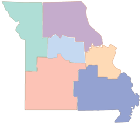at Knob Noster State Park
Organization under the National Park Service
During the Great Depression, a coalition of Kansas Citians proposed the creation of a park area that would serve three purposes: to act as a recreational area for people in the local area; to provide employment relief for those unable to find work during this time; and to rehabilitate approximately 2,700 acres of marginal land, which resulted from unsustainable farming and agriculture. The National Park Service agreed to this project and surveyed the land. Around 3,000 acres were purchased in preparation for development. The National Park Service and the Work Projects Administration began to map out ideas for the park under the direction of administrator A.C. Adams. The final plans for the park were submitted in December of 1935, and construction began in January of 1936. The park was estimated to cost the federal government approximately $230,000.
Montserrat Recreational Demonstration Area
The area developed was called Montserrat Recreational Demonstration Area, due to its proximity to the town of Montserrat. The purpose of a recreation demonstration area was to develop land no longer sustainable for agriculture and rehabilitate it for preservation and conservation. Along with Lake of the Ozarks and Cuivre River, Montserrat was one of three recreation demonstration areas created in the state of Missouri; all of them eventually became state parks. Montserrat Recreation Demonstration Area would also provide a much-needed recreational area for those living in Kansas City and the surrounding area, and away from possible threats of construction and urban sprawl. During the course of development, 315 acres of trees were seeded and planted; around 10 miles of foot trails were constructed; two dining halls and many cabins were built on the sites that would become Camp Shawnee and Camp Bobwhite; and around 20 acres of land were seeded with various flora. Many laborers began to work on the area’s development and administration. Around 200 people were involved in the labor centered around Montserrat Recreational Demonstration Area. Though World War II significantly delayed construction, the project was finished in 1946.
Knob Noster State Park
When the demonstration area’s plans were being finalized, Adams stated that the finished project would be turned over to the State of Missouri, with control of its administration given to the Missouri State Park Board. In 1946, the National Park Service turned over control of the area to Missouri, under the administration of Jean L. Woody, who had initially worked at the demonstration area as a foreman. In 1947, the area’s name was officially changed to Knob Noster State Park. The name came at the behest of judge and former mayor of Knob Noster J.W. Sibert.
We need you! Volunteer today!
Knob Noster State Park is looking for individuals interested in helping with the park’s archival and historic preservation efforts. Get hands-on with the various park files and images! Learn about the park while helping to collect information necessary to piece together the history of Knob Noster State Park!
Knob Noster State Park Today
Knob Noster State Park offers a variety of activities for those young and old, including camping, hiking, mountain biking, horseback riding, fishing and interpretive programs. The park also has two organized group camps. Of these camps, Camp Shawnee, was made into a National Historic District in 1985 and is a part of the National Register of Historic Places as an example of rustic park architecture and reflective of the RDAs created during the Great Depression. Visitors to the park may also spot B-2 bombers from nearby Whiteman Air Force Base.
For more information about the park's history, visit historicmissouri.org and search for stories about Knob Noster State Park.






